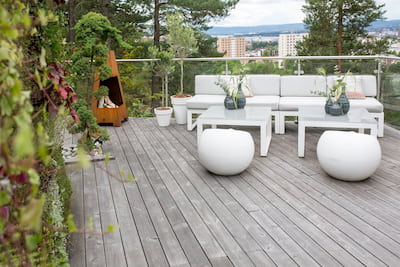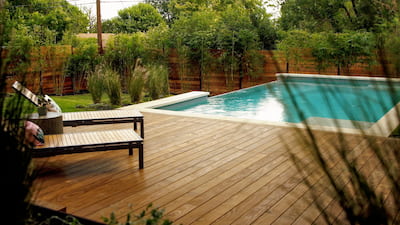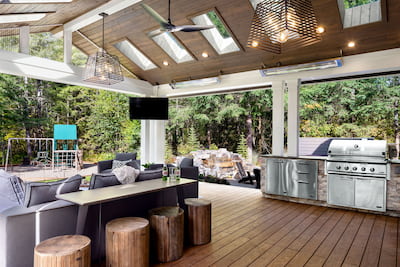What Goes into a Great Deck?
by Rachel Lyon, Editorial Director for Direct from the Designers®
Outdoor living space is what you make it, and there are a lot of choices to make along the way. Decks are particularly diverse—they can be covered or open, stay close to the house or extend well out, and include everything from basic patio furniture to full outdoor kitchens and living rooms. Whatever sort of deck you want to create, the most important part that goes into it is the decking. Here are some aspects of a great deck to help you make the best choice!

Appearance
There’s nothing like a wood deck! Concrete and pavers fall in patio territory, and wood has been the obvious choice for decks and boardwalks for generations. Its visual appeal is multifaceted—people love the color, the woodgrain, and how they can tailor the look with different plank widths and even unique pattern designs. People appreciate a wood deck throughout the seasons even as the elements change its appearance. That’s not true of most other materials!
Wood-look composite decking has gained traction in recent years, but it pales in comparison to the real thing. You can easily identify its plasticky look even if the boards have grain texture and color variation. It also doesn’t weather as well—composite gets dull and worn while wood maintains its character even as it ages. Some think that a synthetic material must outperform a natural one, but that’s not the case here.

Durability
Different materials—natural and man-made—weather in all sorts of ways. Some environmental stresses affect structural integrity while others simply change the appearance. It’s important to consider your particular climate when selecting decking, because it’ll be exposed to the elements 24/7, 365 days per year. Everybody knows that wood’s greatest challenges include moisture and insect damage, but thankfully, these can be addressed. Composite, on the other hand, has been known to warp and deform when exposed to high heat and UV conditions, and there’s nothing you can do to fix that kind of damage.
A wide variety of species are represented in the wood decking market, and not only because they come in different colors. It comes down to durability and longevity in most cases—that’s why you’ll see costly exotics like ipe available for decking, but not advertised for hardwood flooring. You can compare the pros and cons of different species with your climate and budget, but modern technology also offers solutions by improving the hardiness of less expensive woods. You can purchase low-maintenance decking that’s been pre-treated and cured to increase the hardness and dimensional stability of each board, or you can commit to performing regular maintenance on a deck made with untreated lumber. Remember, you should expect the deck to last for decades.

Environmental Impact
Finally, we come to a topic that many people overlook when selecting products for their new homes. Every choice you make has an environmental effect, and the sum of your choices can have a huge impact. There are tons of environmental considerations, but carbon emissions and plastic pollution are the largest two. This is where wood and composite stand in stark contrast—wood sequesters carbon and will naturally decompose back to the earth at the end of its useful lifespan, and composite produces carbon during manufacturing and is less recyclable than consumers have been led to believe, so it will almost certainly end up creating plastic pollution.
Of course, not all woods have the same environmental impact. Harvesting from our rainforests is not a sound ecological strategy; not only does it reduce the amount of atmospheric CO2 that can be absorbed, but shipping lumber long distances also burns a lot of fossils fuels. Additionally, hardwoods take a long time to grow, so they won’t recover in our lifetimes. Softwoods replenish much faster—absorbing carbon as they do—which is why they have been farmed around the world to answer the growing demand for lumber. If you want to make an eco-friendly decision, explore your softwood options.
Kebony® offers decking that checks all the boxes! Their gorgeous real-wood products are made with solid, Forest Stewardship Council-certified pine that has undergone a non-toxic treatment process to increase the thickness of the cell walls. This significantly increases durability, elevating softwood lumber to the level of tropical hardwoods. If you want an outstanding, eco-conscious deck that doesn’t compromise, find a local lumberyard or buy direct! Kebony® is also suitable for indoor use, so if you want a heavy-duty, eco-friendly, real-wood floor you don't have to worry about, look no further!
BROWSE HOME PRODUCT ARTICLES
- Creating a Spa-Like Master Bathroom »
- Designing a Water-Efficient Bathroom »
- Design a Modern Bathroom »
- View All Bathroom Articles »
- Building a New Home »
- Building a Duplex »
- Finding the Right Home Builder »
- View All Building Tips Articles »
- Adding the Right Columns»
- Decorative Touches for Your Interior»
- Shutters for Every Architectural Style »
- View All Columns & Millwork Articles »
- How to Use Specialty Laminates »
- Decorative Touches for Your Home's Interior
- View All Countertops and Surfaces Articles »
- What Goes Into a Great Deck? »
- Decorative Touches for Your Home's Interior »
- View All Decking Articles »
- Choosing Glass for Your Entry »
- Stylish Personas for Your Front Door »
- Using Sidelites and Transoms »
- View All Door Articles »
- Choose Siding for Your Region »
- Get the Most Out of Exterior Paint »
- Mixing Siding to Define Your Exterior »
- View All Exterior Articles »
- Finding the Right Home Builder »
- The Appeal of Small House Plans »
- Choosing the Perfect Floor Plan »
- View All Finding a Home Plan Articles »
- Colorful Flooring for Your Home »
- Designing With Different Widths»
- Chic, Neutral, Gray Flooring »
- View All Flooring Articles »
- Garage Doors That Add Curb Appeal »
- Caring for Your Garage Doors »
- Benefits of Insulated Garage Doors »
- View All Garage Door Articles »
- Reclaimed Products for Your Home »
- Building a Green and Stylish Home »
- Benefits of Building with SIPS »
- View All Green Building Articles »
- Cool Gadgets for Your New Home »
- Creating a Hi-Tech Home »
- Efficient Gifts for New Homeowners »
- View All Home Electronics Articles »
- Improve Your Home's Air Circulation »
- How to Improve the Air Circulation in Your Home »
- View All HVAC Articles »
- Bedrooms Designed for Sleep »
- Selecting a Fireplace for Your Home »
- Crafting a Luxurious Master Suite »
- View All Interior Design Articles »
- Design the Perfect Outdoor Space »
- Dive into a Beautiful Pool »
- Design a Sizzling Outdoor Kitchen »
- View All Outdoor Living Articles »
- Apps to Help You Pick Paint Colors »
- Create the Perfect Mood with Paint »
- How to Read the Color Wheel »
- View All Painting & Decorating Articles»
- Creating a Spa-Like Master Bathroom »
- High-Impact Kitchen Upgrades »
- Creating a Water Efficient Bathroom »
- View All Plumbing Fixtures Articles»
- Cladding That Complements Your Exterior »
- Reasons to Consider Prefinished Siding »
- View All Siding & Cladding Articles»
- All About Solar Powered Skylights »
- Natural Lighting for the Dark Corners of Your Home »
- Design a Better Bedroom with Skylights »
- View All Skylight Articles»
.png)
.png)
